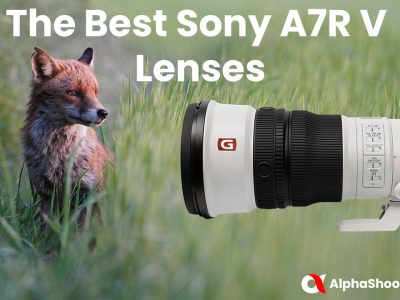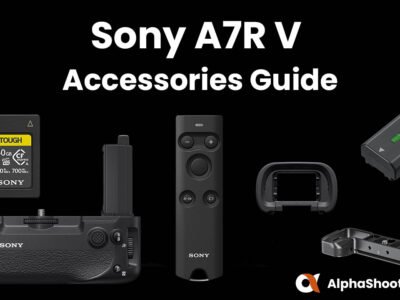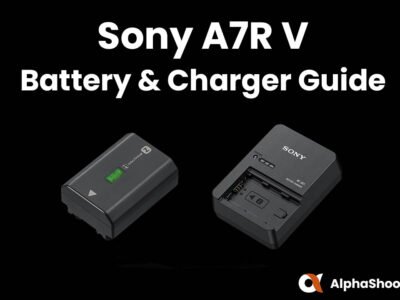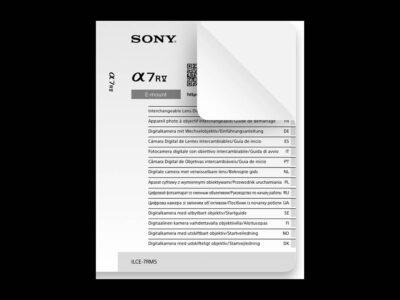The Sony a7R V now supports the much faster CFexpress Type-A memory cards in both of its memory card slots.
However, because only Sony, Prograde, Delkin, Lexar and more recently Exascend are making CFexpress Type-A cards, they are still rather expensive.

Due to their high price you might be wondering whether or not you really need to use a CFexpress Type-A card?
Especially when the a7RV also supports UHS-II/I SD cards which are much cheaper per GB.
Well, although you can certainly use UHS-II and UHS-I cards, there are two instances when you might want to use a CFexpress Type-A card.
Shooting in S&Q Mode With XAVC S-I 4k (2x Slow Motion)
If you want to shoot in S&Q Mode with the file format XAVC S-I 4k, a record frame rate of 30p/25p/24p and a frame rate of 60fps / 50fps (2x slow motion) then you will need a CFexpress Type A card. The a7R V will not let you record in this specific format with a V90 card.
However, you could still record in one of the none S&Q video formats and then interpret the footage in post. You won’t be able to view the S&Q footage in camera and this is an extra post processing step, but now you won’t require a CFexpress card and you’ll also get audio since recording in S&Q does not record audio.
Burst Shooting
If you enjoy shooting any type of action then you will probably be shooting a lot of bursts. If you use a CFexpress Type-A card not only will you be able to take more shots before hitting the buffer compared to a UHS-II card, the buffer will also clear much faster.
Here are the results of my Sony a7RV in-Camera Speed and Buffer Tests using a Lexar Professional CFexpress Type-A Gold card which was the fastest CFexpress Type-A card in my tests.
| Image Type | Shots Before Hitting Buffer | Time to Clear Buffer (Seconds) |
|---|---|---|
| Uncompressed RAW (132.8MB) – 7 fps | 199 | 7.08 |
| Compressed RAW (71.4MB) – 10 fps | Over 1000 | < 2s |
| Lossless Compressed RAW L (80.1MB) – 7 fps | Over 1000 | < 2s |
| Lossless Compressed RAW M (48.3MB) – 7 fps | Over 1000 | < 2s |
| Lossless Compressed RAW S (37.1MB) – 7 fps | Over 1000 | < 2s |
| JPEG Extra Fine (49.6MB) – 10 fps | Over 1000 | < 2s |
| Uncompressed RAW (132.8MB) + JPEG Extra Fine (49.6MB) – 7 fps | 65 | 10.78 |
| Compressed RAW (71.4MB) + JPEG Extra Fine (49.6MB) – 10 fps | 104 | 18.35 |
| Lossless Compressed RAW L (80.1MB) + JPEG Extra Fine (49.6MB) – 7 fps | 72 | 9.95 |
| HEIF (4:2:2) Extra Fine (24.9MB) – 10 fps | 771 | 7.90 |
And here are the results of my Sony a7RV in-camera speed and buffer tests using a Sony SF-G Tough UHS-II card which was the fastest UHS-II card in my tests.
| Image Type | Shots Before Hitting Buffer | Time to Clear Buffer (Seconds) |
|---|---|---|
| Uncompressed RAW (132.8MB) – 7 fps | 50 | 19.81 |
| Compressed RAW (71.4MB) – 10 fps | 105 | 21.28 |
| Lossless Compressed RAW L (80.1MB) – 7 fps | 66 | 12.26 |
| Lossless Compressed RAW M (48.3MB) – 7 fps | 151 | 7.43 |
| Lossless Compressed RAW S (37.1MB) – 7 fps | Over 1000 | < 2 |
| JPEG Extra Fine (49.6MB) – 10 fps | 143 | 14.73 |
| Uncompressed RAW (132.8MB) + JPEG Extra Fine (49.6MB) – 7 fps | 43 | 26.81 |
| Compressed RAW (71.4MB) + JPEG Extra Fine (49.6MB) – 10 fps | 84 | 33.05 |
| Lossless Compressed RAW L (80.1MB) + JPEG Extra Fine (49.6MB) – 7 fps | 47 | 18.95 |
| HEIF (4:2:2) Extra Fine (24.9MB) – 10 fps | 658 | 8.11 |
As you can hopefully see, the CFexpress cards allow you to take many more shots before hitting the buffer and clear it a lot faster.
Summary
If you want to shoot in S&Q Mode with the file format XAVC S-I 4k, a record frame rate of 30p/25p/24p and a frame rate of 60fps / 50fps (2x slow motion) then you will need to use a CFexpress Type A card.
If you like shooting continuous bursts then a CFexpress Type-A card will allow you to take many more shots before hitting the buffer, it will also clear the buffer a lot faster than UHS-II cards will allow.
If you are interested in further speed and buffer tests then I’ve tested 6 CFexpress Type-A and 13 UHS-II memory cards in my Sony A7R V Memory Card Guide.








Now that I’ve taken my new A7RV out for a second shoot, I have my own reaction to this question.
At the moment I’m using uncompressed RAW + JPEG, mainly because my normal suite of tools for processing RAW do not yet support this camera. So my favourite 160GB CFeA cards only hold 800-odd images – that feels like so few! With my A1, using just lossless compressed RAW (L), I’m getting over 2200 images on the same cards.
I discovered that Sony has announced a 256GB SD in the Tough G range – seemed perfect! Sadly, those cards aren’t yet available here, even though they are listed for sale 🙁
My current 128GB Sony Tough G SD cards are only showing 700-odd image count with the uncompressed RAW + JPEG. I think I’ll use SD cards more often on this camera than on the A1, especially if I can get the 256GB G SD cards! Yeah, I know I could get the 320GB or 640GB CFeA cards, but I’d rather not sell my car to get them 😀
I’ll be keen to see what the capacities will be like when I can switch to shooting just lossless compressed images – your estimated file size suggests I’ll get about 2000 images to a 160GB card.
Roll on ACR support for the A7RV!